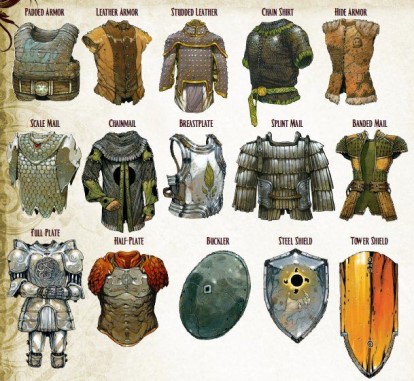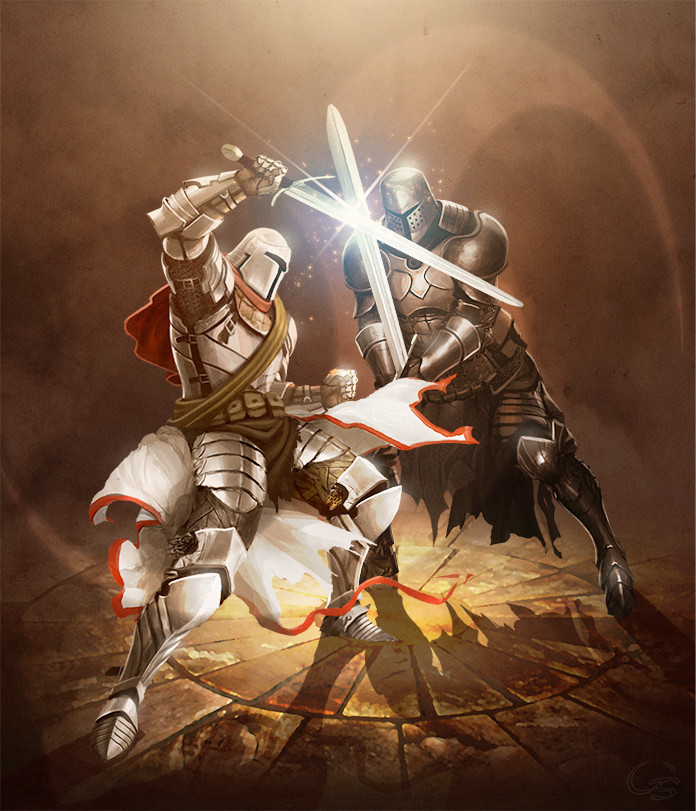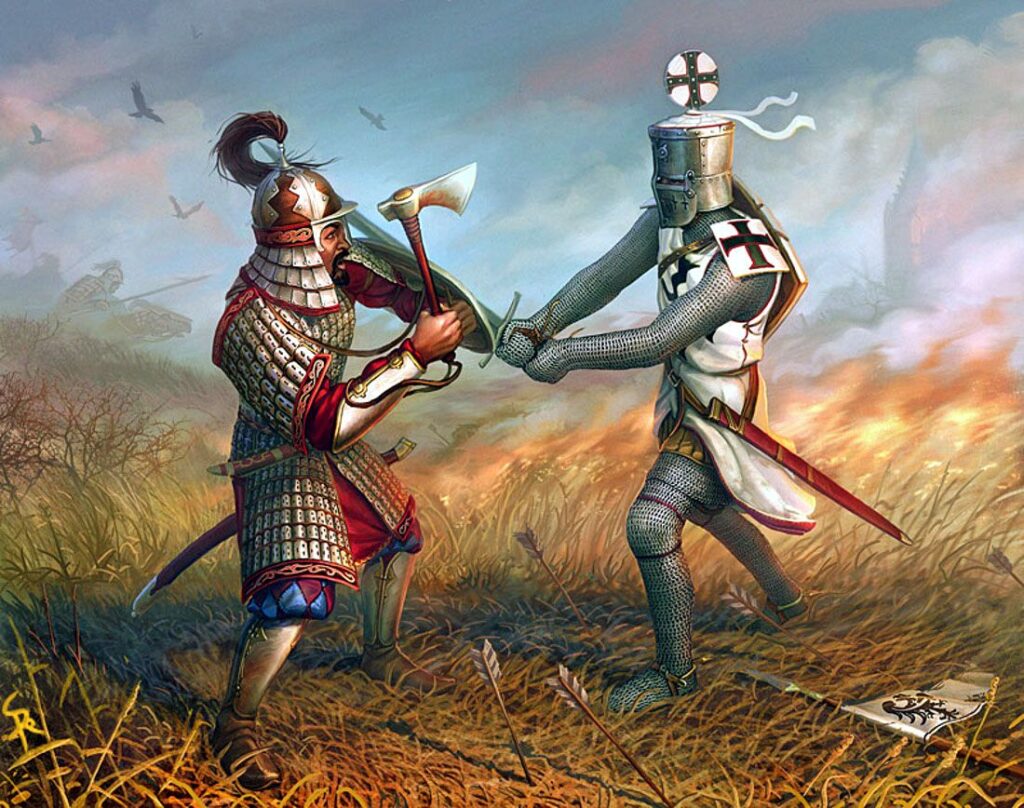
This week I begin a new series of posts I’m calling “The Game Mechanic.” For each letter of the alphabet, I’m going to discuss a relevant RPG mechanic (or as close as I get) and look at the various ways the mechanic can be implemented. For my first entry, I’ll be discussing Armor as a game mechanic. Enjoy!
Armor as a game mechanic can be traced back even farther than the advent of the first tabletop RPG in 1974, to miniature wargames. In the abstract, Armor can refer to any mechanic that prevents a character or unit from taking harm, whether physical, magical, or otherwise. When implemented in an RPG, the Armor mechanic tends to fall into one of two categories: damage avoidance or damage mitigation. Each implementation has its own pros and cons.
 Armor as damage avoidance is the oldest and most common implementation of Armor, going all the way back to the first iteration of D&D. In this conception, armor prevents the user from being hit, and therefore from taking damage. The idea here, is that landing a blow subtracts from a target’s HP, and so wearing armor makes it more difficult for an attacker to land a blow, with a “miss” narratively representing an attack striking harmlessly against a target’s armor (sometimes these misses are narrated as a poorly-directed swing or a dodge, but I digress). This form of damage avoidance is a perfectly valid implementation of the Armor mechanic; it jives with the main goal of wearing armor, namely to help its wearer avoid harm by covering their flesh. This type of Armor mechanic is not without its criticisms, however. Critics argue that armor shouldn’t be conceived as preventing a character from being hit, but rather that armor should reduce the amount of damage taken by a hit up to the point that a character may take no damage from a hit at all.
Armor as damage avoidance is the oldest and most common implementation of Armor, going all the way back to the first iteration of D&D. In this conception, armor prevents the user from being hit, and therefore from taking damage. The idea here, is that landing a blow subtracts from a target’s HP, and so wearing armor makes it more difficult for an attacker to land a blow, with a “miss” narratively representing an attack striking harmlessly against a target’s armor (sometimes these misses are narrated as a poorly-directed swing or a dodge, but I digress). This form of damage avoidance is a perfectly valid implementation of the Armor mechanic; it jives with the main goal of wearing armor, namely to help its wearer avoid harm by covering their flesh. This type of Armor mechanic is not without its criticisms, however. Critics argue that armor shouldn’t be conceived as preventing a character from being hit, but rather that armor should reduce the amount of damage taken by a hit up to the point that a character may take no damage from a hit at all.
 Armor as damage mitigation is the other main implementation of the mechanic. In this form, Armor doesn’t normally make a target harder to hit, but rather it reduces the amount of damage the target takes when a hit does land. In fact, many implementations of the Armor mechanic actually make it easier for the wearer to be hit, representing the encumbering nature of armor in exchange for greater protection against harm. Regardless, when used as a form of damage mitigation, Armor acts as a buffer to lessen a blow to the point that a target may take no damage from a hit at all. Proponents argue that this is a more realistic portrayal of how armor works since in real life a person can get hurt through blunt force and bruising even if a weapon hits their armor instead of their flesh; the armor lessens the blow rather than helping the wearer avoid the hit completely. This is another perfectly reasonable implementation of Armor, though it does have its detractors. One powerful argument against armor as damage reduction is that armor doesn’t necessarily prevent an opponent from making contact with a target’s flesh. Indeed, many armored fighters historically fell victim to an attack that landed in between the joints of their armor, receiving flesh wounds in the process.
Armor as damage mitigation is the other main implementation of the mechanic. In this form, Armor doesn’t normally make a target harder to hit, but rather it reduces the amount of damage the target takes when a hit does land. In fact, many implementations of the Armor mechanic actually make it easier for the wearer to be hit, representing the encumbering nature of armor in exchange for greater protection against harm. Regardless, when used as a form of damage mitigation, Armor acts as a buffer to lessen a blow to the point that a target may take no damage from a hit at all. Proponents argue that this is a more realistic portrayal of how armor works since in real life a person can get hurt through blunt force and bruising even if a weapon hits their armor instead of their flesh; the armor lessens the blow rather than helping the wearer avoid the hit completely. This is another perfectly reasonable implementation of Armor, though it does have its detractors. One powerful argument against armor as damage reduction is that armor doesn’t necessarily prevent an opponent from making contact with a target’s flesh. Indeed, many armored fighters historically fell victim to an attack that landed in between the joints of their armor, receiving flesh wounds in the process.
The truth of the matter is that either implementation of Armor is valid because either can be incorporated into the narrative of an attack in a way that makes sense. Ultimately, which form of Armor is used is entirely dependent on the preferences of the game designer(s) and the players themselves. In fact, there’s no reason you couldn’t incorporate both forms of Armor, though the consequence will be that armor will be a very powerful possession, and it may make combats drag on longer than intended. If a gaming group wanted to go this route, I would suggest making armor very expensive and easily damaged/ruined.
So, what’s your preferred implementation of the Armor mechanic? Do you agree or disagree with the arguments made for or against either? Which game do you think does Armor best? Let me know in the comments!
Do you have thoughts or questions about the article or suggestions for future content? Leave a comment below or drop me a line at jtdimino@d20radio.com.
J.T. Dimino
Latest posts by J.T. Dimino (see all)
- The PC Factory: Aedan the Druid (Old School Essentials) - January 26, 2021
